
Switzerland - mgb Matterhorn-Gotthardbahn + former FO Furka-Oberalpbahn, BVZ Brig-Visp-Zermattbahn
For a full scale picture, please click on the picture shown !
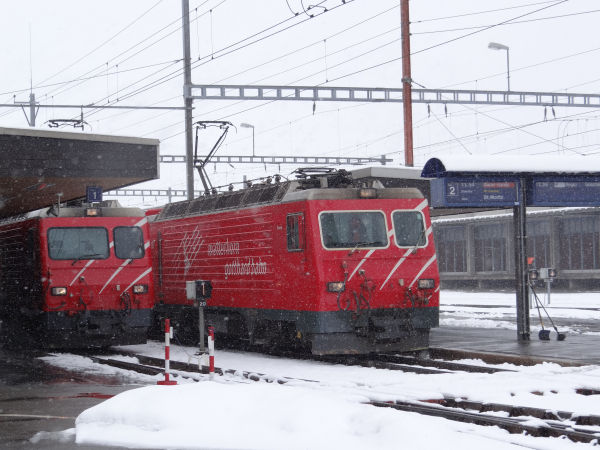
The mgb Matterhorn-Gotthardbahn was a fusion product of the companies FO Furka-Oberalpbahn and BVZ Brig-Visp-Zermattbahn. mgb has a network
of 144 kilometres of metre gauge rails with much of it fitted with a cog wheel rail of the sytem Abt. The endpoints are Disentis and Zermatt. The line is electrified
with 11 kV AC 16,7 Hz. The highest point of the line is 1564 metres above sea level.
These HGe 4/4 II locomotives are both for adhesion and for Abt rack rail use. They were ordered jointly by FO, BVZ and what then SBB Brünigbahn. 21 locomotives
of this type were built since 1985. It can run 100 km/h on adhesion and 40 km/h on system Abt rack rails.
Picture from Andermatt station 1.5.2016 by Ilkka Siissalo.
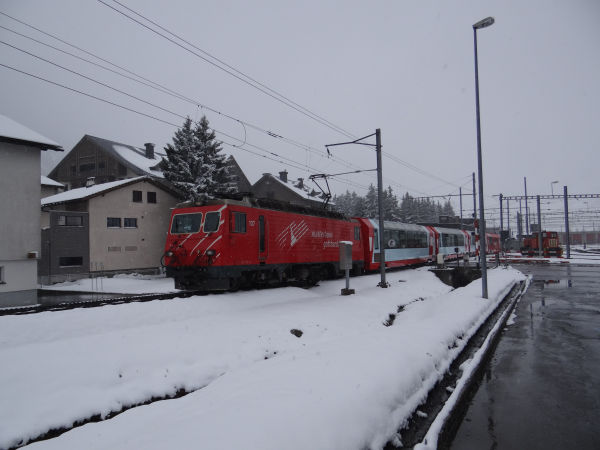
The famous - and expensive - express train Glacier Express with its special coaches is just leaving Andermatt station and heading towards Disentis, where it will be
taken over by Rhätische Bahn RhB locomotives. Glacier Express is often said to be the slowest moving express train in the world, since on the rack rails its top speed
is only 40 km/h and it normally doesn't run even that fast.
Picture from Andermatt station 1.5.2016 by Ilkka Siissalo.
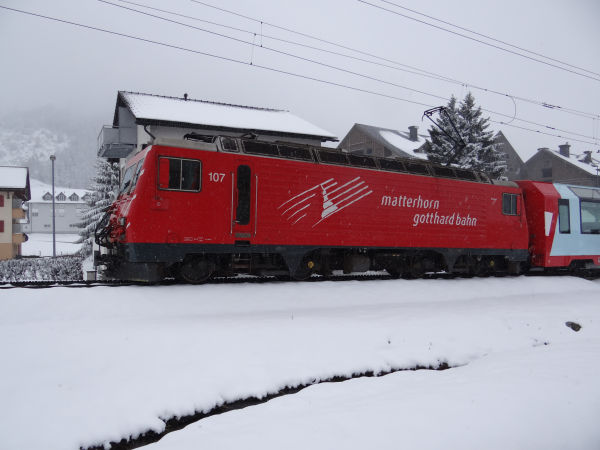
Exactly here, just about 150 metres uphill from Andermatt station is the spot where the rack rails begin. This HGe 4/4 II locomotive has just clibed on the rack rail and will now begin
its steep climb towards Disentis.
Picture from Andermatt station 1.5.2016 by Ilkka Siissalo.
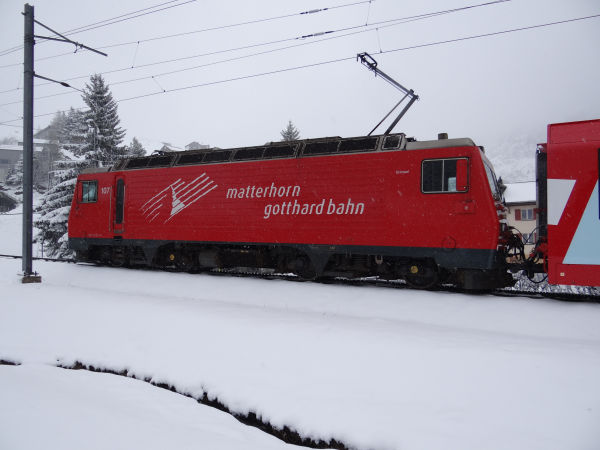
There it goes, slowly but surely.
Picture from Andermatt station 1.5.2016 by Ilkka Siissalo.
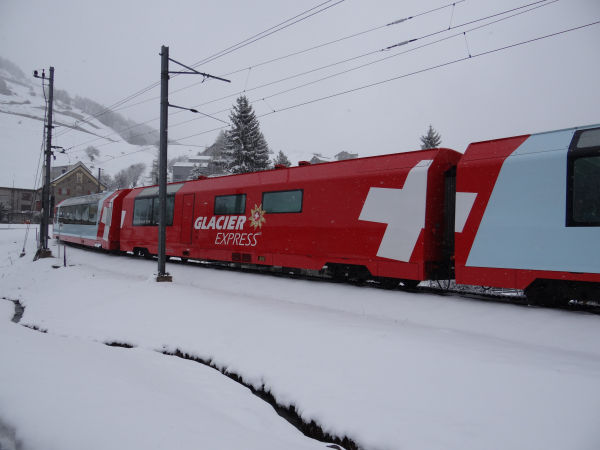
The Glacier Express' panorama bar coach.
Picture from Andermatt station 1.5.2016 by Ilkka Siissalo.

There it goes.... Bye-bye.
Picture from Andermatt station 1.5.2016 by Ilkka Siissalo.

mgb and before that, the FO, has for tens of years used the same old set of an Deh 4/4 motor wagon plus a couple of old coaches for the short but steep
climbing route from Göschenen to Andermatt. But new rules say that trains and trams should be accessible even for people who for example use wheelchairs.
To achieve this, mgb has bought one new wagon with a low-floor section and put that in the middle of the old train.
Picture from Andermatt station 1.5.2016 by Ilkka Siissalo.
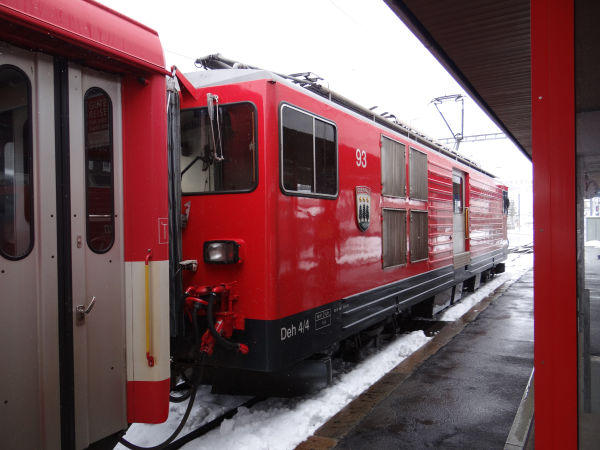
mgb usually uses type Deh 4/4 motor wagons for the short route between Andermatt and Göschenen. The motor wagon is always located in that end of the train which
will be deepest down on the very steep slope.
Picture from Andermatt station 1.5.2016 by Ilkka Siissalo.
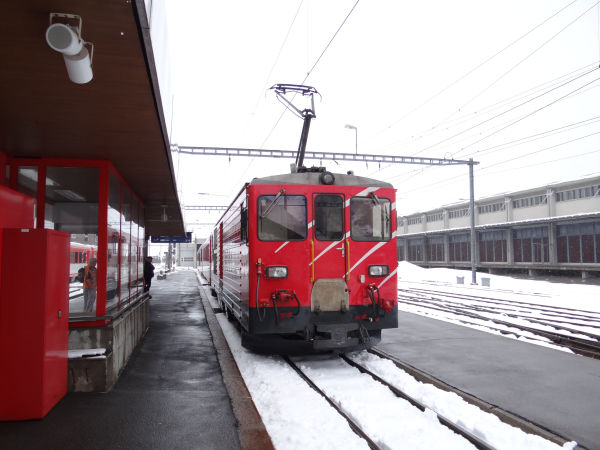
The same Deh 4/4 as above, but seen from its front.
Picture from Andermatt station 1.5.2016 by Ilkka Siissalo.
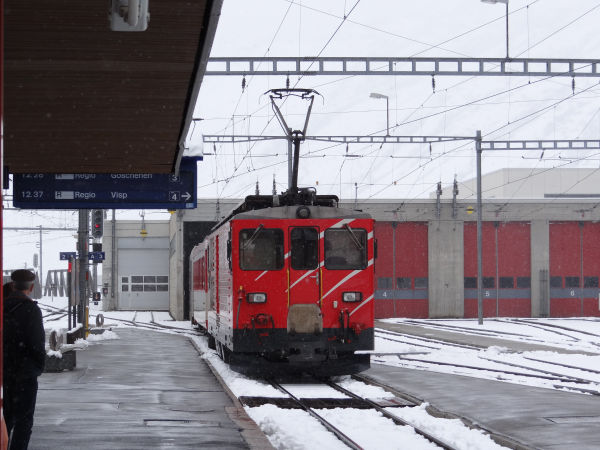
The Deh 4/4 is pushing its train into the garage.
Picture from Andermatt station 1.5.2016 by Ilkka Siissalo.

At mgb it is customary to often keep both pantographs up when the train is standing on a station and also when it is starting. Then well underway, one of them may be
lowered. Their electric system has a relatively low voltage and to avoid excessive currencies it is better to have multiple feeding points when the need of electricity
is greatest.
Picture from Andermatt station 1.5.2016 by Ilkka Siissalo.
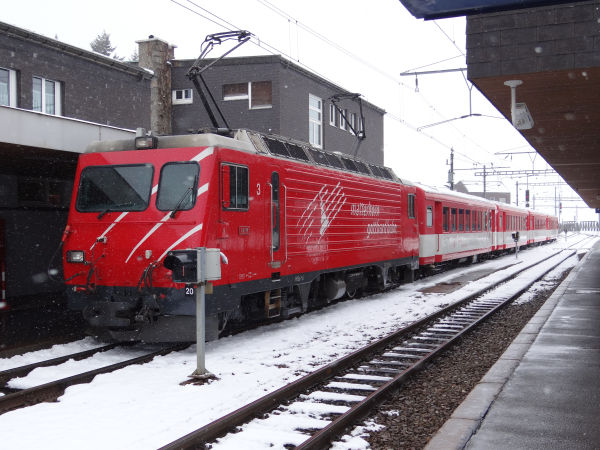
The same train as above but seen from its front.
Picture from Andermatt station 1.5.2016 by Ilkka Siissalo.
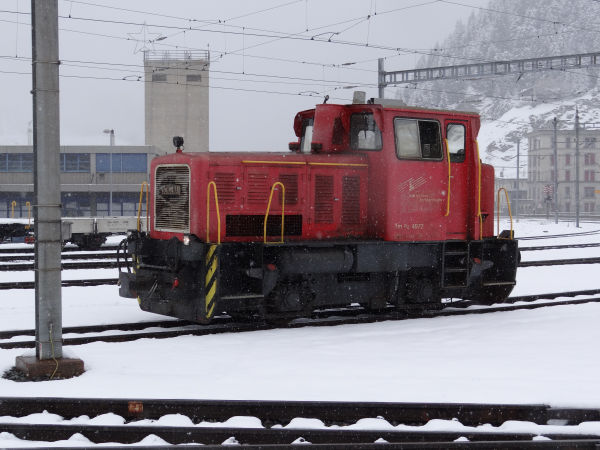
Andermatt is one of the center points of operation for the company mgb. This small Schöma locomotive, formerly an FO machine, stood for years and years
always at the Andermatt station ready to do shunting of wagons.
Picture from Andermatt station 1.5.2016 by Ilkka Siissalo.
The former FO Furka-Oberalpbahn
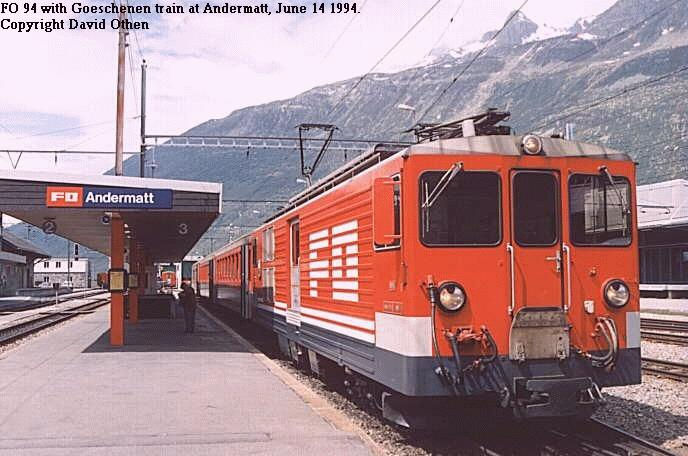
Furka Oberalp Deh 4/4 no. 94 is not classified as a locomotive but as an EMU (it has a small package department). Here it is seen at Andermatt station with train
for Göschenen 14. June 1994. The Deh 4/4 was one of the most common locomotives at FO. It was built some time between 1980-84. It weighs 49,5 tons, is 15,5 m long
and has a maximum speed of 60 km/h, a speed which is never used on the mountain lines. FO had altogether 6 of these engines plus a further 5 of an earlier but fairly
similar series (Deh 4/4 no.51-55) from 1972-75. The line between Göschenen (in the valley, by the "big" railroad of SBB's Gotthard Pass mountain route) climbs
extremely steeply up a short strech to the mountain village of Andermatt, high up, where it meets FO's mountain line. The Göschenen-Andermatt trains used to take also
private cars which do not or cannot climb the steep climb.
Photo by Pat & David Othen. Uploaded Nov 22, 1995, text edited by I.S. 22.5.2002.
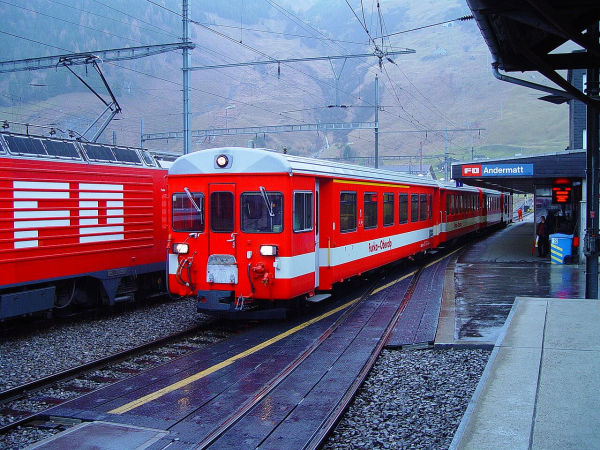
This picture is still from those times when there was no mgb Matterhorn-Gotthardbahn, but the central part of the later mgb was still called FO Furka-Oberalpbahn.
The picture is from Andermatt and the train in the front is the pendeling train of the short route from Andermatt down the steep hill to Göschenen, a very short, but
very steep cog wheel third rail drive line connecting the Furka-Oberalp service with the state railways SBB down at Göschenen. The only task of this short train and its similar
sibling was/is to run the couple of kilometres very steeply down the gorge from Andermatt down to Göschenen where the line meets the SBB "big train" line to get
passengers from the state railway line to come to Andermatt and thus to the FO/mgb service.
Picture from Andermatt 2.11.2002 by Ilkka Siissalo.
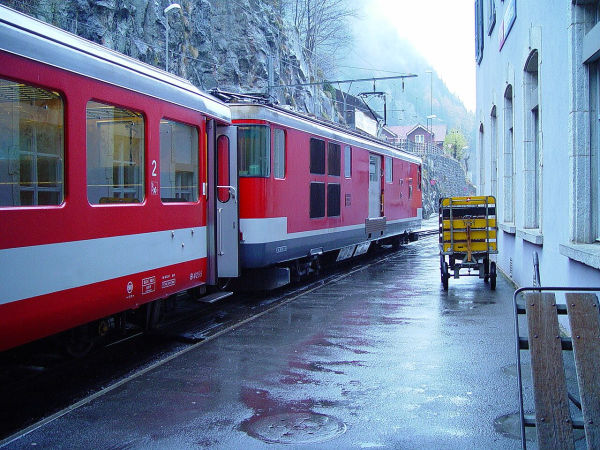
A Furka-Oberalp FO locomotive and its first coach "down under" at the station of Göschenen where the steep line up to Andermatt begins. Technically speaking this
Deh 4/4 I is not even classified as a "locomotive" as it also contains a cargo department in the middle. But these machines are the power basins for the service
on the Göschenen to Andermatt gorge line. They are always kept at the lower end of the train, so on the journey towards Andermatt it will always be pushing the
train uphill with a steering cab coach first. You can see the steering cab coach in the picture above.
Picture from Göschenen 2.11.2002 by Ilkka Siissalo.
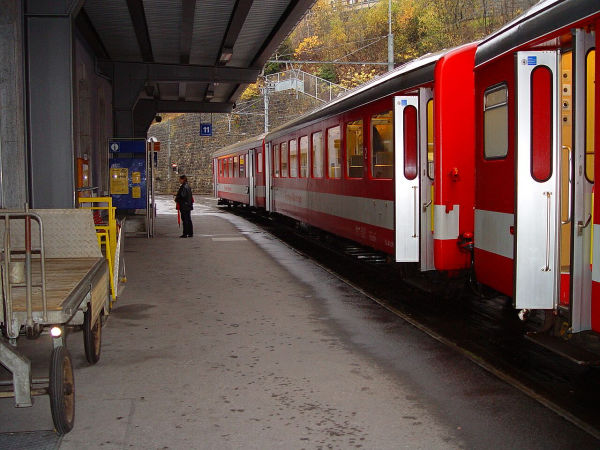
Coaches of the Furka-Oberalp service from Göschenen up to Andermatt in 2002. The last coach in the line with the yellow stripe over the windows indicating
first class is the steering cab coach which will lead the train uphill to Andermatt. The lady in the picture is train photographer Sanna Siissalo.
Picture from Göschenen 2.11.2002 by Ilkka Siissalo.

The same locomotive - well, not quite, but "Triebwagen" - with its cargo department and its set of coaches now soon ready to be pushed steering cab coach first
and this machine last uphill to Andermatt. The machine is Furka-Oberalp's Deh 4/4 I no.53.
Picture from Göschenen 2.11.2002 by Ilkka Siissalo.
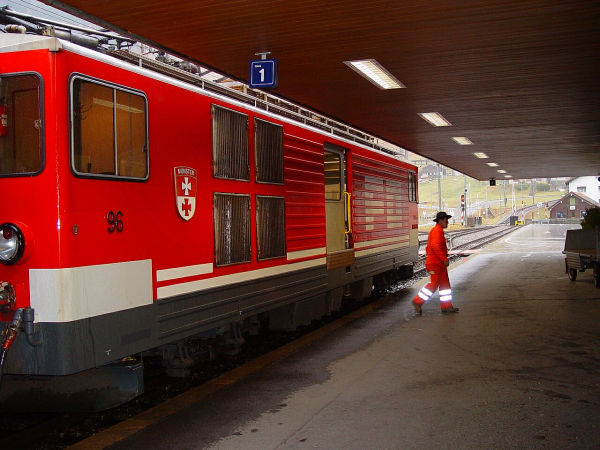
Furka-Oberalp Deh 4/4 II no.96 is much newer, but was used for the same purpose, the short Andermatt to Göschenen service.
Picture from Andermatt 2.11.2002 by Ilkka Siissalo.
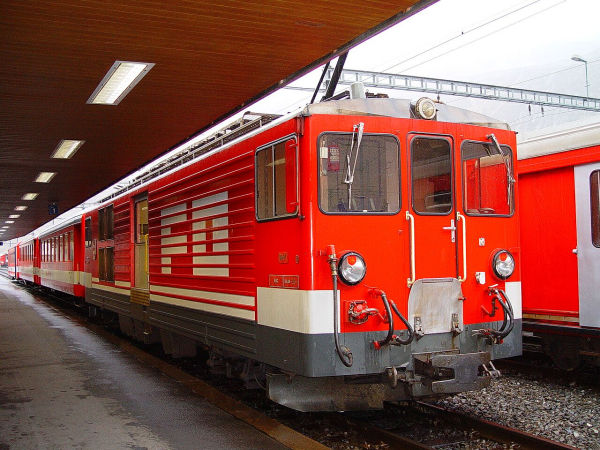
The same Furka-Oberalp Deh 4/4 II no.96 seen from its front.
Picture from Andermatt 2.11.2002 by Ilkka Siissalo.
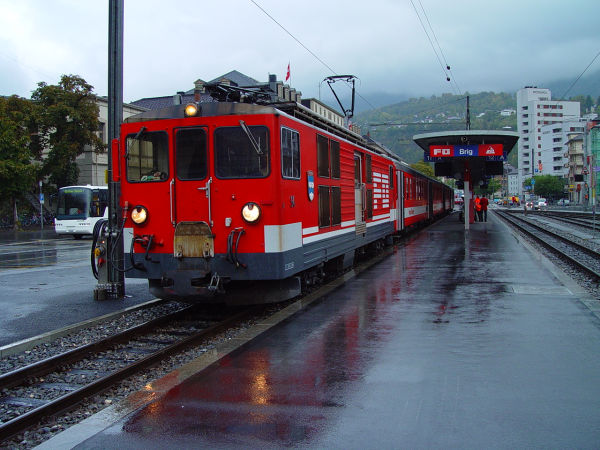
The Deh 4/4 motorwagons of FO were a bit newer than the almost similar ones used by the company BVZ. For the equivalent BVZ wagons,
see at the bottom of this page. This motor wagon no.94 was one of a series of six, numbered 91-96. They were built in two batches in 1979
and 1984. Their top speed on adhesion rails is 60 km/h and on cog wheel rails 30 km/h.
Picture from Brig 6.10.2002 by Ilkka Siissalo.

A Furka-Oberalp so called express train (not too fast!) ready to leave Andermatt towards Brig. The locomotive is HGe 4/4 II no.104.
Picture from Andermatt 2.11.2002 by Ilkka Siissalo.
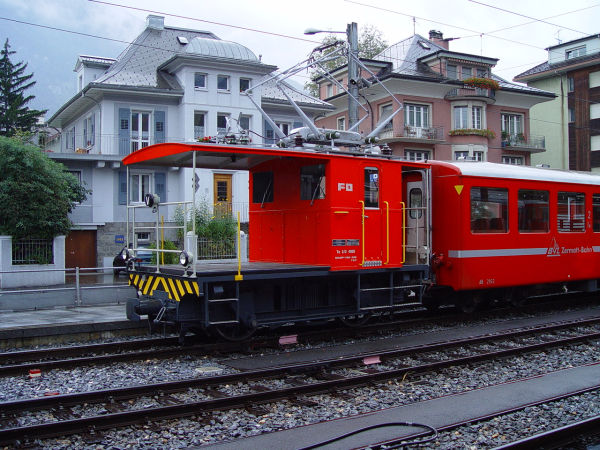
Already long before the railroad companies FO and BVZ were fusioned to become mgb Matterhorn-Gotthardbahn, the two companies had a very
deep cooperation. Here is one example. The rather exotic looking electric shunter locomotive was owned by FO, but here it was moving a train of
BVZ to the station of Visp. This little locomotive was built in 1946 and it remained all of its active life at Brig and Visp. Today the machine
belongs to MGBAHN Historic, an organisation taking care of old trains of FO and BVZ.
Picture from the station of Visp 6.10.2002 by Ilkka Siissalo.

The same train as above. The small Te 2/2 shunter locomotive of FO was just bringing these coaches to the station. Thereafter an EMU
wagon of the type Deh 4/4 of BVZ cam to take the train to lead it uphill to Zermatt.
Picture from the station of Visp 6.10.2002 by Ilkka Siissalo.
The former Brig - Visp - Zermattbahn BVZ
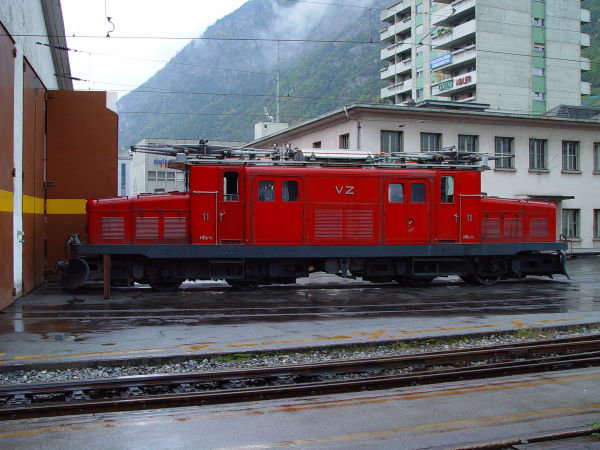
The former Brig-Visp-Zermatt railroad BVZ is also today a part of the prent day mgb Matterhorn-Gotthardbahn. This old historic machine
is/was the HGe 4/4 no.11 of the former BVZ. Here it is seen in front of the old locomotive shed of BVZ in Visp.
Picture from Visp 6.10.2002 by Ilkka Siissalo.
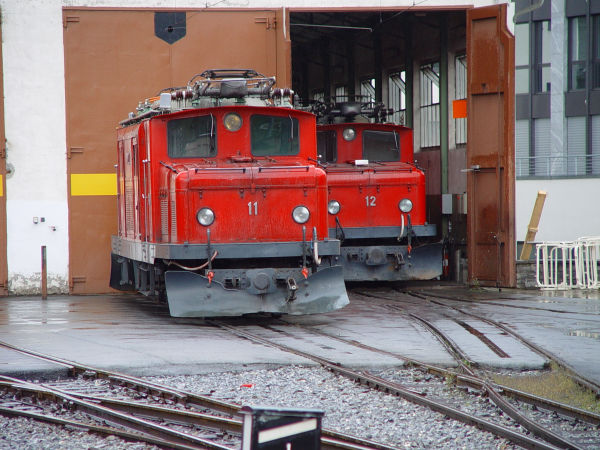
The same BVZ old locomotive HGe 4/4 no 11 as shown above, with a similar sister locomotive no.12 inside the shed. There was a small series
of these locomotives, numbered 11 to 15 and built in 1929 to 1930 by SLM, MFO and SWS. Today these machines belong to MGBAHN Historic,
an organisation taking care of historic trains of the mgb group of companies.
Picture from Visp 6.10.2002 by Ilkka Siissalo.
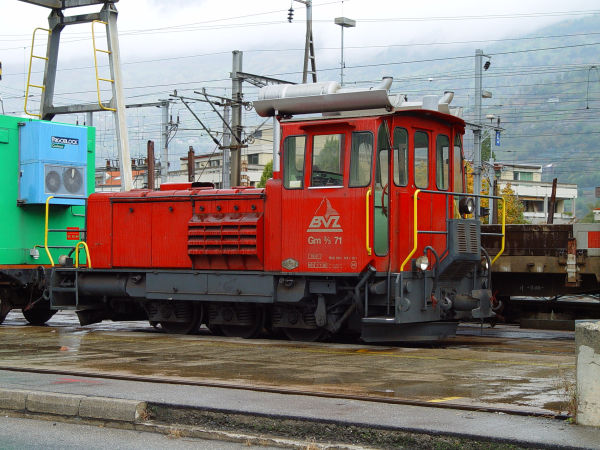
This small industrial diesel locomotive no.71 belonged to the former Brig-Visp-Zermatt railroad BVZ. It was always stationed in Visp.
It was built in 1973 by the French company Moyse. It weighs 26 tons and has a maximum speed of only 45 km/h. It's a pure adhesion
locomotive which cannot by itself climb from Visp to Zermatt. A second similar machine no.72 has been for years and years stationed in
Zermatt.
Picture from Visp 6.10.2002 by Ilkka Siissalo.

A very typical train of the BVZ railway in 2002. The locomotive is of the type HGe 4/4 II, similar to the ones used also at the Furka-
Oberalpbahn of that time. The passenger coaches are aluminium coaches from the 1960s and 1970s.
Picture from Visp 6.10.2002 by Ilkka Siissalo.

Not all the trains of BVZ up to Zermatt were in 2002 pulled by a locomotive of the type HGe 4/4 II, but some of the lighter trains were
pulled by these Deh 4/4 motor wagons. Technically this is not a locomotive, but a motor wagon (In German Triebwagen), since it has
a cargo and baggage room in its middle.
Picture from Visp 6.10.2002 by Ilkka Siissalo.
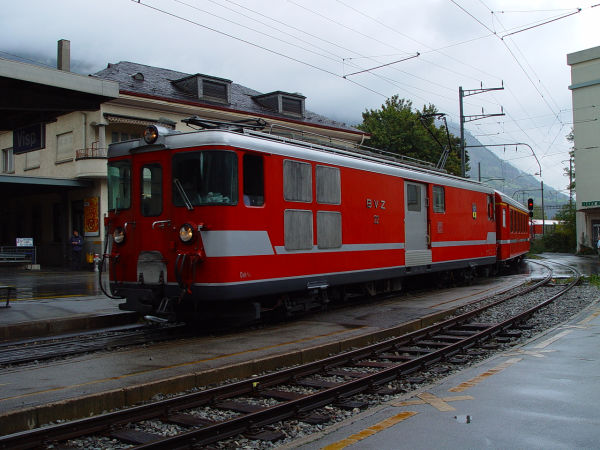
The same motor wagon ("Triebwagen") Deh 4/4 no.22 as in the picture above, here leading its train from Visp to Zermatt. These machines
were built 1975-76 and there were four of them at BVZ. More of the same machines were also at FO. Its top speed on adhesion rails
is 65 km/h and on cog wheel rack rails 35 km/h. The machines weigh 49 tons and they have a power rating of 1094 kW using 11 kV AC.
Picture from Visp 6.10.2002 by Ilkka Siissalo.

